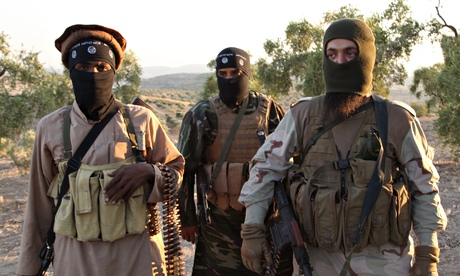
Isis militants near Aleppo in Syria in October 2013. Photograph: Alamy
US president's partners in battle against militants in Iraq and Syria have previously failed to stand up when tested
After securing broad regional support for his coalition against Islamic State (Isis) Barack Obama is now turning to the second part of his strategy: empowering proxies on the ground who – in theory – will finish what air strikes started.
The US president's plan, though, invests immense faith in partners and would-be allies that have done little to display their worth in alliances that are, in many cases, at least a decade old. Of all the US-backed armies or rebel groups in the region, only a few have stood up when tested – and none of them recently.
The best armed and trained of them all, the Iraqi military, surrendered northern Iraq – and all of its arsenals – in less than 48 hours in mid-June, which is the main reason Obama is scrambling to take on a battle-ready Isis now.
The rout of the Iraqi army was one of the most extraordinary in modern military history. Five divisions numbering roughly 120,000 soldiers and officers fled as the jihadis advanced towards Mosul, Tikrit and Kirkuk, changing the face of the modern Middle East and posing a serious threat to states from the Levant to the Gulf and well beyond.
In August, the Isis rampage turned north towards the notional Kurdish capital of Irbil, where another US-trained ally – the Kurdish peshmerga forces – also rapidly retreated, leaving half a million Yazidis and Christians to fend for themselves.
Across the now redundant border with Syria, the Syrian army – though not a US partner – had been struggling to contain an insurrection against the country's leadership until it was reinforced by Iran and its proxies, especially Hezbollah, in December 2012.
Now, from Damascus to Baghdad, non-state actors are leading the fighting, with what remains of the Syrian and Iraqi armies subservient to them.
Iranian-backed Shia militias are directing key battles, including the fight earlier this month to regain the Turkoman town of Amerli, which had been surrounded by Isis since late June.
The campaign saw an extraordinary convergence of interests, with the US air force providing game-changing air cover to its arch-foe, the Iranian Major General Qassem Suleimani, who was on the ground as militias he directed rescued the Turkomans.
The Iraqi army played a support role, just as it has elsewhere in Iraq in every attempt to claw back its losses. Ever since, it has not been deployed anywhere in the country without large numbers of militias.
In Syria, where the US air campaign is now turning, militias are also dominant. The Syrian opposition is split into two main groupings. The Syrian revolutionary council – which is backed by Saudia Arabia – will be expected to lead the counterattack against Isis. But its influence is limited by the terrain it controls, roughly a wedge of land from northern Idlib province to the edge of Aleppo.
Beyond that the Islamic Front – backed by Qatar and Turkey but viewed warily by the US – holds sway and has been the main bulwark against Isis. Neither group gets on, and while heavy weapons and training could buy influence with either, there is little to show from their track record against Assad that they could defeat an even more formidable foe.
There is, however, one precedent for success – the partnership between the US military and the Sunni tribes of Anbar province, who revolted against al-Qaida in Iraq in early 2007. The then occupying US army threw its full weight behind the initiative, and the jihadis were ousted after around nine bloody months. Several years of relative quiet followed, but now they are back, stronger than ever, and with the world's most powerful army not on the ground to take them on.
"This is a big, big stretch," said a senior US official who was in Iraq at the time of the awakening. "Nothing I have seen inspires confidence that our new friends can get things done, especially when the old (friends) failed so miserably."


No comments:
Post a Comment